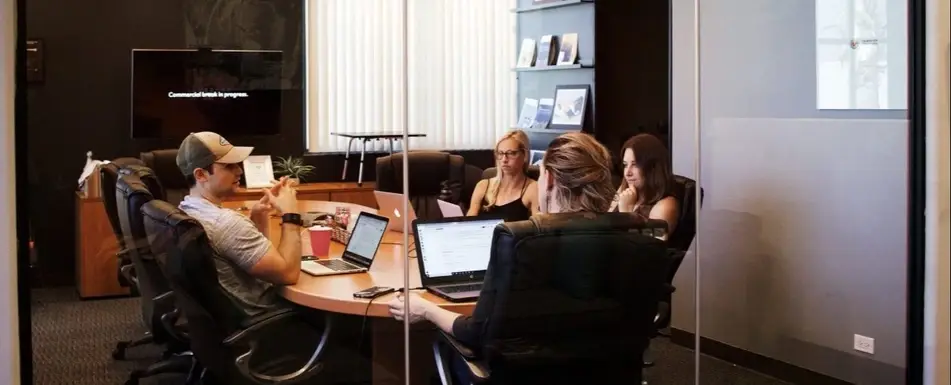Meeting Norms | Our Guide to Getting Started (Part 2)

You already know that meeting norms can be a game changer, and if you need a refresher, you can read Part One here. Perhaps you’re even convinced that meeting norms could benefit your team and support equity in your office.
But how can you put this information into action? The process of creating shared meeting norms can be an excellent team-building activity when done well. Here’s a quick guide to creating norms and taking your group’s work to the next level.
How to create norms as a team
Team leaders facilitating this discussion should send some prompts in advance so that team members can reflect on the needs of the team ahead of time. This method offers you a wider diversity of opinions and input, which will help to make space for better norms that truly help align your team. Remember that it’s easy to fall into “group think” once one idea has been said out loud.
Here are a few sample questions to get people thinking:
- Consider a great team you worked on in the past. What were the things that made it amazing?
- Think about a negative team experience you have had in the past. What made it challenging?
- Are there specific problems or challenges you ran into on teams in the past? In hindsight, can you think of any solutions to these challenges? Were there specific behaviors or assumptions that contributed to those problems?
You should also include one or two sample norm statements for reference.
Six steps to setting new norms
With your prep work complete, here is your six-step guide for running a meeting to create team norms:
- Set the context. Review what norms are and why you’d like to develop them together. Make sure you include time for introductions.
- Write it out. Give everyone a sticky notepad to jot down the behaviors and actions that contributed to past positive team experiences. Share responses by sticking on a wall or flip chart.
- Discuss. Read each suggested norm out loud and discuss the idea or concept together. If there are similar items, cluster them together and discuss them as a unit.
- Refine. Re-write each cluster of ideas into a full sentence that provides a behavioral guideline for your work together. Review the item and decide if it captures the essence of what was discussed. This is a good place to check in on whether your meeting norm is reinforcing or disrupting existing dominant culture norms.
- Adopt. As a group, decide if you are in agreement that a given norm is important. Will it improve your work together? Is it something you can commit to for the duration of your work (or at least until the next norm review)? Items for which there is no consensus can be tabled for further discussion.
- Make it official. The meeting facilitator should transcribe your norms and share the list with everyone. This list should be printed and visible in your meeting space; you may also choose to include the list on each agenda as a regular reminder.
Pro Tip: Meeting norms should never be created without the input of all members of the team who is expected to follow them. A top-down approach to creating meeting norms defeats the purpose.
Putting norms to work
Now we need to talk about how to use these norms when we inevitably slip up and fall a little short of our ideal behavior as teammates. The best thing about norms is that everyone agreed to them—which means everyone can respectfully and kindly hold one another to shared standards.
Imagine this scenario:
You’re in your biweekly staff meeting and Teammate A keeps checking their phone while others are talking. You arrive at an agenda item focused on their area of expertise and responsibility, but they are tuned out.
There are some annoyed glances from other team members. After the meeting, Teammate B tells Teammate C, “I get so irritated when A doesn’t listen to what’s happening in the meeting! I share important information and then always have to repeat myself again because they weren’t listening.”
Eek. Not great.
Let’s go back to one of the sample norms provided in Part One: “We will be engaged and present during our time together and limit our use of electronic devices to emergencies only. If there is a reason we need to be less present, we will communicate that to the group at the beginning of the meeting.”
Holding team members accountable
Now imagine how you might use that norm to correct Teammate A’s negative behavior—without grumbling, judgement, or gossiping with a third person.
- Option one: Briefly review your meeting norms at the start of the meeting. They should already be posted in your meeting space, and perhaps included with your agenda or other materials. Recap norms and ask, “Are we all able to fully commit to our working agreements before we begin?”
- Option two: When you send the follow-up notes and action items from the meeting to your team members, invite them to share (confidentially) any comments or concerns about how well the team upheld the agreed-upon norms. Feedback you receive can serve as a discussion point or reminder at the beginning of your next meeting.
Both of these options are direct, clear, and designed to involve the people in the meeting. The best part is that you get an opportunity to proactively create the culture of your work together, rather than reactively trying to address it when someone does not meet expectations.
That’s not to say you will never have to address a team member’s meeting behavior directly. However, in the case that that becomes necessary, you have the language of your shared working agreements—and a record of that teammate’s participation in their creation—to aid you in a one-on-one conversation if the need arises.
With the right level of preparation, meeting norms can be a powerful tool for more productive meetings. Creating them collaboratively—whether that’s with staff members, volunteers, or community work groups—can help to ensure buy-in throughout your organization.
Did you enjoy this post? There's plenty more where this came from! Subscribe here for updates.
Ashley Fontaine is a writer, mental health professional, and former nonprofit executive director. She’s on a mission to eliminate “we’ve always done it that way” from our collective vocabulary by helping leaders focus on possibilities rather than limitations. She believes organizational culture is the key to productivity and staff retention.


